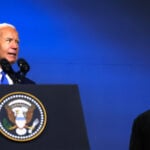SEOUL, South Korea (AP) — North Korea said Wednesday it successfully tested new solid-fuel engines designed for intermediate-range ballistic missiles as it works on enhancing its nuclear-capable arsenal with more powerful, harder-to-detect weapons that can potentially target U.S. military bases in Guam and Japan.
North Korea’s official Korean Central News Agency said the country’s military scientists tested the first-stage and second-stage missile engines on Saturday and Tuesday. The report did not say when the new missile system was expected to be completed.
The tests extend a torrid run in North Korea’s weapons development efforts, which some analysts say could be boosted by an alleged arms cooperation with Russia as they align in the face of separate, intensifying confrontations with the United States.
Tuesday’s test came as Russia’s natural resources minister, Alexander Kozlov, arrived in North Korea for talks over unspecified trade and technology exchanges, as the countries continued to build on a rare summit in September between North Korean leader Kim Jong Un and Russian Vladimir Putin.
Kim’s trip to the Russian Far East, where he also visited major rocket and military sites, sparked concerns about a potential arms alignment between the countries, in which North Korea provides munitions for Russia’s war in Ukraine in exchange for Russian technology transfers that would upgrade Kim’s military nuclear program.
The North’s existing intermediate-range missiles, including the Hwasong-12 that may be able to reach the U.S. Pacific territory of Guam, are powered by liquid-fuel engines, which need to be fueled before launch and cannot stay fueled for long periods of time.
Missiles with built-in solid propellants can be made ready to launch faster and are easier to move and conceal, which theoretically makes it harder for adversaries to detect and preempt the launch in advance.
The recent tests were an “essential process for further enhancing the strategic offensive capabilities of (North Korea’s) armed forces in the light of the grave and unstable security environment facing the country and the future military situation in the region, in which the enemies will get more vicious in their military collusion and nexus,” KCNA said.
North Korea’s claims that the engine tests were successful suggest the country will flight-test the new missile in the coming weeks, said Cheong Seong-Chang, an analyst at the private Sejong Institute in South Korea. The missile could pose a potential threat to Guam, a major U.S. military hub, and to American military bases in Japan, which may add to Japan’s urgency to upgrade its military and further expand three-way security cooperation with Seoul and Washington, Cheong said.
When asked about North Korea’s missile engine tests, Japanese Chief Cabinet Secretary Hirokazu Matsuno said the North is clearly trying to improve its “sneak attack capability.” “We think North Korea possibly takes further provocative actions, including missile firings and nuclear tests, and the Japanese government will do its utmost for information gathering, analysis and reconnaissance,” he said.
Tensions on the Korean Peninsula are at their highest point in years after Kim ramped up his weapons demonstrations, including events he described as simulated nuclear attacks on the South. He also authorized his military to launch preemptive nuclear strikes against enemies if it perceived Pyongyang’s top leadership to be under threat.
South Korea has responded by expanding its combined military exercises with the United States, which Kim has condemned as invasion rehearsals, and enhancing trilateral security cooperation with Japan. Seoul is also seeking stronger public assurances from Washington that it would swiftly and decisively use U.S. nuclear weapons to protect the South in case of a North Korean nuclear attack.
In the allies’ latest show of force, the United States deployed at least one nuclear-capable B-52 bomber and F-35 and F-16 fighter jets to train with South Korean warplanes on Wednesday above the South’s western seas, Seoul’s Defense Ministry said. The ministry said in a statement that the joint exercise was aimed at demonstrating the allies’ capabilities to “instantly, overwhelmingly and decisively respond” to any North Korean provocations.
During their annual security talks this week, U.S. Defense Secretary Lloyd Austin and South Korean Defense Minister Shin Won-sik signed an updated bilateral security agreement with the aim of more effectively countering North Korea’s evolving nuclear and missile threats.
Shin said the new document spells out that the United States would mobilize its full range of military capabilities, including nuclear, to defend the South in the event of a North Korean nuclear attack. He also said the document would be a template for the allies to strategize how South Korea could assist U.S. nuclear operations in such events with its conventional capabilities but didn’t elaborate further.
North Korea earlier this year revealed its first solid-fuel intercontinental ballistic missile, the Hwasong-18, which has the potential ability to reach deep into the U.S. mainland.
Analysts say the North has to clear further technological hurdles to have a viable nuclear arsenal that could threaten the United States.
All of North Korea’s ICBM tests so far were done at high angles to avoid the territory of neighbors, so it’s not yet clear whether the country has mastered the technology to ensure its warheads would survive atmospheric reentry well enough to precisely hit their targets.
The North also has a variety of shorter-range solid-fuel missiles that are designed to be fired from land vehicles, silos or submarines. Some of these missiles are designed to be maneuverable and fly at low altitudes, theoretically giving them a better chance of defeating missile defense systems in South Korea.
U.S. and South Korean officials have repeatedly raised concerns that North Korea could receive Russian technological support to enhance the threat of its nuclear and missile programs in exchange for providing munitions and military equipment to boost Russia’s warfighting capabilities in Ukraine.
South Korean intelligence and military officials have said North Korea may have shipped more than a million artillery shells to Russia beginning in August, weeks before Kim’s meeting with Putin. Both Moscow and Pyongyang have denied U.S. and South Korean claims about the alleged arms transfers.
Separately, KCNA reported the visit by a Russian delegation led by Kozlov. The report said the two sides were engaged in talks over trade, science and technology exchanges, but it did not elaborate further.
The Associated Press had reported he arrived in Pyongyang on Tuesday. __ Associated Press writer Mari Yamaguchi in Tokyo contributed to the report.
___
Follow AP's Asia-Pacific coverage at https://apnews.com/hub/asia-pacific

 Making any New Year's resolutions? Here are some tips to help make them stick
Making any New Year's resolutions? Here are some tips to help make them stick
 Argentine judge charges 5 people over death of former One Direction star Liam Payne
Argentine judge charges 5 people over death of former One Direction star Liam Payne
 Federal appeals court upholds sexual abuse verdict against Trump
Federal appeals court upholds sexual abuse verdict against Trump
 2024 has been a nerve-wracking year for plane travel. How safe is it really?
2024 has been a nerve-wracking year for plane travel. How safe is it really?
 These decisions on refugees weren’t popular. Jimmy Carter made them anyway
These decisions on refugees weren’t popular. Jimmy Carter made them anyway
 US stocks fall with one trading day left in 2024
US stocks fall with one trading day left in 2024
 The world population will be 8.09 billion on New Year's Day after a 71 million increase in 2024
The world population will be 8.09 billion on New Year's Day after a 71 million increase in 2024
 US announces $5.9 billion in military and budget aid to Ukraine
US announces $5.9 billion in military and budget aid to Ukraine
 Auriemma ties VanDerveer for most appearances at one school in women's AP Top 25; UCLA remains No. 1
Auriemma ties VanDerveer for most appearances at one school in women's AP Top 25; UCLA remains No. 1








